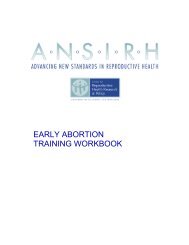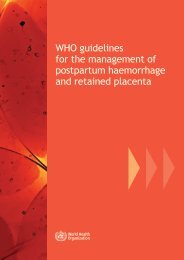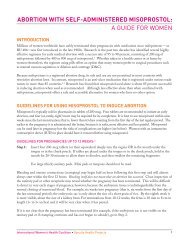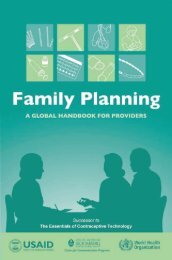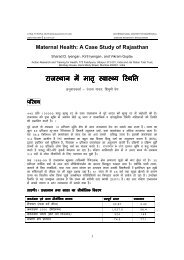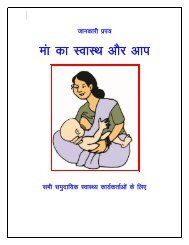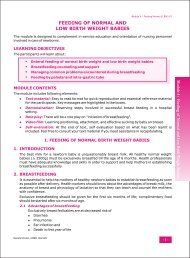Uterine evacuation with manual vacuum aspiration ... - CommonHealth
Uterine evacuation with manual vacuum aspiration ... - CommonHealth
Uterine evacuation with manual vacuum aspiration ... - CommonHealth
You also want an ePaper? Increase the reach of your titles
YUMPU automatically turns print PDFs into web optimized ePapers that Google loves.
Clinical Skills Evaluation<br />
UTERINE EVACUATION FOR INCOMPLETE/MISSED ABORTION:<br />
Instructions: The trainer should use one form to evaluate the ability of each learner based on direct observation of<br />
the learner’s management of an incomplete abortion case, including performance of <strong>manual</strong> <strong>vacuum</strong> <strong>aspiration</strong><br />
(MVA). Proficiency in MVA service delivery requires demonstrating competency on all items in Part I. If a learner<br />
does not demonstrate competency or cannot be observed, refer to Part II where recommendations can be made as to<br />
how performance might be improved to achieve competency. After completing the form, the trainer should discuss<br />
the results <strong>with</strong> the learner.<br />
Mark an X in the box next to each step that is competently demonstrated by the learner.<br />
I. Clinical Skills<br />
❑ 1. Establishes rapport <strong>with</strong> the woman, helping her feel comfortable<br />
❑ 2. Assesses the woman’s status: medical history, presenting conditions, date of LMP, emotional state<br />
❑ 3. Provides or confirms that the woman received counseling: privately explores her decisions<br />
❑ 4. Discusses the procedure <strong>with</strong> the woman and obtains consent<br />
❑ 5. Evaluates need for and administers pain management based on the woman’s condition and her desires<br />
❑ 6. Uses infection-prevention practices: handwashing, gloves<br />
❑ 7. Assesses uterus: size, position, trauma<br />
❑ 8. Identifies cervical laceration or trauma<br />
❑ 9. Identifies possible reproductive tract infection<br />
❑ 10. Ensures that the cannulae are HLD or sterile and rinsed of caustic solutions<br />
❑ 11. Prepares aspirator and checks <strong>vacuum</strong><br />
❑ 12. Selects cannula based on uterine size and dilatation; inspects cannula and aspirator for wear<br />
❑ 13. Swabs cervix, and vagina if desired, <strong>with</strong> antiseptic solution<br />
❑ 14. Administers paracervical block and any other medications; allows time for medications to take effect<br />
❑ 15. Dilates the cervix, if needed<br />
❑ 16. Inserts cannula and attaches aspirator<br />
❑ 17. Uses no-touch technique; does not contaminate the cannula<br />
❑ 18. Moves cannula effectively to empty the uterus<br />
❑ 19. Stops <strong>evacuation</strong> when signs of completion are present<br />
❑ 20. Examines the aspirate to assure it is consistent <strong>with</strong> the woman’s condition<br />
❑ 21. Assures post-procedure care is provided to monitor and discuss her recovery<br />
❑ 22. Assures contraceptive counseling and a method are provided if the woman desires<br />
❑ 23. Assures follow-up care is scheduled <strong>with</strong> referrals made where needed<br />
II. Recommendations.<br />
For skills that were not performed to competency or were not observed, suggest recommendations to be followed,<br />
for example: “needs to continue practice under supervision” or “repeat clinical training.”<br />
Item<br />
Recommendation<br />
____________________ __________________________________________________________<br />
____________________ __________________________________________________________<br />
____________________ __________________________________________________________<br />
____________________ __________________________________________________________<br />
UTERINE EVACUATION WITH MVA: A TRAINING MANUAL FOR CONDUCTING SHORT COURSES Page 36



